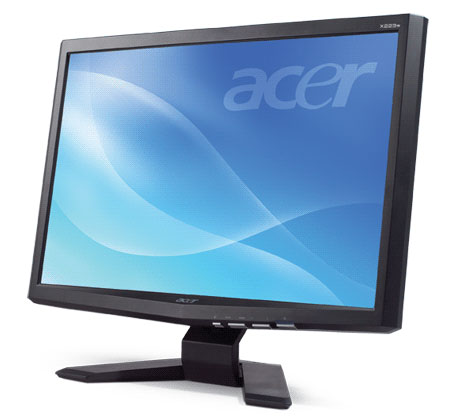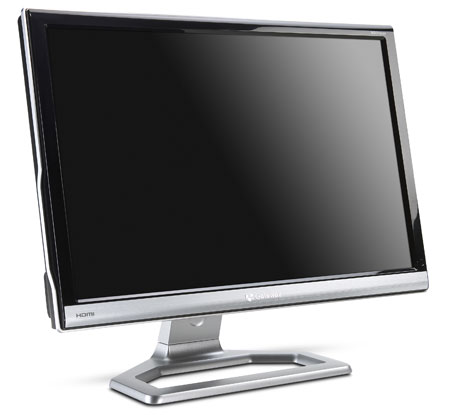Sub-$200 Options

There are plenty of options under $200 these days, but we tend to have a philosophy of "go big or go home" when it comes to LCDs. Do you really want to get a slightly better quality 19" LCD when $20 more will get you a 22" LCD? We certainly don't, and thus our recommendation ends up going to one of the many 22" LCDs currently priced under $200. Acer is more of a value brand in the LCD market, but that doesn't mean the LCDs aren't good. In fact, other than flimsy base stands we've never had a complaint with any of the Acer LCDs we've used. Specifications are pretty much meaningless at this price point -- all of the 22" LCDs that cost under $200 will be very similar, i.e. TN panel, 1680x1050, 5ms response times, HDMI and/or DVI -- so it really comes down to price and availability. Acer is a global company so their products are available around the world, and their prices are also very good. The Acer X223Wbd won't be the best LCD around, but for only $170 it's hard to complain. It is missing HDMI support, however, so if that's important we would recommend the ASUS VH226H, which also happens to bump up the resolution to 1920x1080 and only costs $40 more.
$200-$400 Recommendations

Not surprisingly, this is by far the largest category in terms of the available options. You can get everything from good quality 22" LCDs (or 20" S-IPS LCDs) up to and including 28" monsters of somewhat dubious quality. If the latter catches your fancy, check out the Hanns•G HG-281DPB at Newegg, currently going for only $380. Yes, that's less than most 24" LCDs, so we wouldn't expect best in class performance. What would we actually recommend? 22" offerings are going to be slightly better in terms of features and quality, but we would recommend going for a 24" LCD. Our overall recommendation goes to the Gateway FHD2401, a slight update to our Bronze Editors' Choice FHD2400 that uses a matte panel instead of a glossy panel. You still get a plethora of input options, and one of the best base stands that we've ever used.
If you're still looking for other alternatives, Dell has recently launched their 23" SP2309W that has a native resolution of 2048x1152 -- yes, higher than 1080P. We actually think 1080P movies will look best on 1080P displays, but for Windows work a slightly higher resolution might be useful. You still get a TN panel, and the price is quite a bit higher than 22" 1080P LCDs at $380. Acer once again shows up with the X243Wbd for $290, and we also have the BenQ E2400HD that we recently reviewed, now at $330. We wouldn't call the BenQ E2400HD perfect, but honestly for the price it's very good, especially if you never intend on using it at anything other than the native 1920x1080 resolution -- and we always recommend using native resolution on any LCD. Its "younger brother" E2200HD should also be available shortly, with a price in the low to mid $200 range.










50 Comments
View All Comments
anandtech02148 - Thursday, December 18, 2008 - link
nice review,I bought the Dell 2408 when it was 512, price have drop a little in 4weeks. Regarding input lag, some suggest using hdmi cable to connect instead of dvi to improve signal lag. Does this really work?
Spivonious - Thursday, December 18, 2008 - link
I wouldn't see why. HDMI is DVI+Audio.USRFobiwan - Thursday, December 18, 2008 - link
Nice but a little short I think. I have one thing I do not agree on HD TV's and their lag story. What about all the people that play their Xboxes and PS3's. Never seen any lag on those on the big screendijuremo - Thursday, December 18, 2008 - link
He taking about input lag, not response time. Take a look at this:http://en.wikipedia.org/wiki/Input_lag">http://en.wikipedia.org/wiki/Input_lag
It has an animation/video where you can clearly see the LCD is running behing the CRT. Now you should realize how those kids frag you so much in counterstrike using their old CRT... :)
HollyDOL - Thursday, December 18, 2008 - link
well, human optical nerves have reuse downtime of about 35-40ms, so anything below that is unrecognisable for human... Count in brain cheating with the image big way as well and you find out there is no chance to detect that without some device help.Spivonious - Thursday, December 18, 2008 - link
Ever noticed flicker in a 60Hz or even a 75Hz monitor? I have. That means my eye can pick up changes of 13ms.HollyDOL - Thursday, December 18, 2008 - link
You are mixing two things together. First of all, CRT monitor flickering you can see is result of your eye catching with various pixel intesities over time... While LCD screen pixel loses only relatively small part of intensity before it gets refreshed, CRT screen pixel virtualy goes between nothing and everything every time. I'll try to find out pictures describing it and post it here later.Hard fact is that data running from your eyes to brain is transfered as a electrical currency (=fast) only inside neurons. Two neurons transfer the 'bit' between themselves using chemical reaction of Natrium - Kalium bridge. Simple as that to be able to transfer next bit, the chemical levels need to rebalance and perform further chemical processes to provide that and thus you have got huge speed bottleneck there.
If your eye could pick up 13ms, you would see your old CRT screen like waved something with bad colouring and light intensity would go up and down like if you were turning your light in room on and off.
It's very much same with watching movies - it seems fluent to you. You don't watch series of photos with sound (like you would if you had 13ms nerves), but movement. What everybody recognises as fluent movement is just and only your brain interpolating between two static frames it received through optical nerve... that's the reason all the videos are in about 25FPS (40ms) frame rate. Simply because human doesn't need more because human can't recognise more. Whoever says otherwise is either E.T. or lies to his own pocket. The hard cap of eye nerve bandwidth simply doesn't allow that.
mczak - Thursday, December 18, 2008 - link
LCD screens do not lose any part of intensity whatsoever over time - unless you'd count backlight flicker (which is afaik several kHz)...JarredWalton - Thursday, December 18, 2008 - link
I can tell you from experience that you will certainly notice the 40ms lag on some monitors; I don't have a problem with 20ms models, but the 2408WFP, Samsung 245T, and several other LCDs are perceptibly slower. You can't *see* it looking at things side by side, but use it and you can feel the lag. Even in using Windows, the mouse just feels like its sluggish and unresponsive. Gaming is even worse at times, depending on the game and how competitive you are.I didn't think it was a problem either, until I got a few truly laggy displays and did further testing. For a while I actually just thought the lag was the cheap Dell mouse I had connected to a test system, and then when I tested one of the TN panels I suddenly realized that the mouse was fine. Basically it felt like I had a cheap wireless mouse where everything was imprecise.
HollyDOL - Thursday, December 18, 2008 - link
Well, don't forget there is significant lag on computer side as well. It takes some msecs for the software to move the cursor as well... Effect acumulates with further lag on monitor and pain begins. The lag effect should be much more visible with linux systems due to their switching of kernel and user modes of cpu. Could be worth trying out.